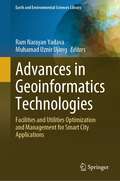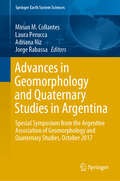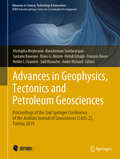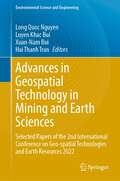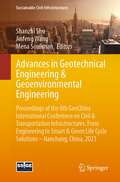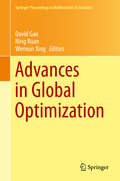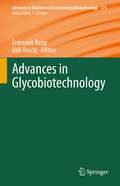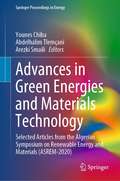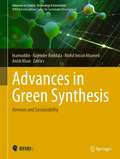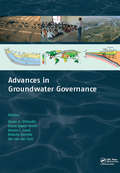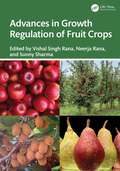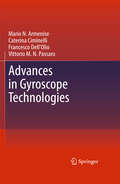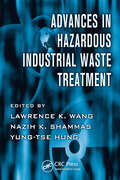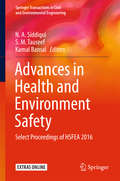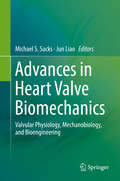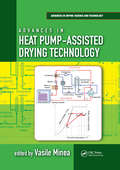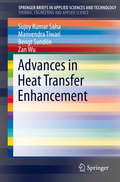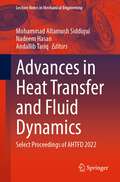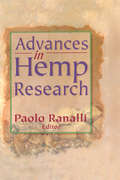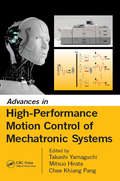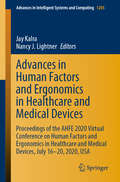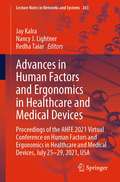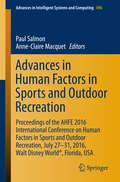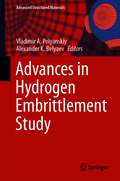- Table View
- List View
Advances in Geoinformatics Technologies: Facilities and Utilities Optimization and Management for Smart City Applications (Earth and Environmental Sciences Library)
by Ram Narayan Yadava Muhamad Uznir UjangThere are many GIS products for smart cities to implement smart city projects or activities. Most of the Geoinformatics Technologies and its application books are theoretical and lack of examples with real world data and step by step explanations to understand the facilities and utilities optimization and management for smart city applications and socio-economic aspects.This book focuses and discusses topics related to how technological advances in Geoinformatics can help in the management operations of smart city applications to help our environment to be smart. Specifically, the volume focuses on how these advancements can help optimize and manage facilities and utilities. This book focuses on geoinformation modelling, geo-smart city applications, geoinformation technology, information system and computer science, and geolocation and positioning as its five primary areas of discussion. Each of these primary subjects delves into the application that uses geoinformatics technology in greater depth. This covers the use of Geoinformatics technology in the prevention of crime, coastal erosion, carbon emission modelling, landslide modelling, urban farming, and various other applications linked to the field. This book's objective is to provide a comprehensive review of the accomplishments that geoinformatics has made in a number of different application areas for smart cities. It covers Geoinformation Technologies, Geoinformation Modelling, Information System and Computer Science, Geolocation & Positioning, and Geo-Smart City Applications.The book will be useful to graduate students, university faculty, and researchers in Geoinformatics sciences/engineering and architecture and town planning. It will also be useful to entrepreneurs, professionals, and planners in policy and decision making at the local, state and national levels.
Advances in Geomorphology and Quaternary Studies in Argentina: Special Symposium from the Argentine Association of Geomorphology and Quaternary Studies, October 2017 (Springer Earth System Sciences)
by Jorge Rabassa Mirian M. Collantes Laura Perucca Adriana NizThese proceedings contain selected papers from the Special Symposium, organised by the Argentine Association of Geomorphology and Quaternary Studies in October 2017. This Symposium was held within the frame of the 20th Argentine Geological Congress in Tucumán, Argentina. The papers describe detailed research on quaternary stratigraphy and geochronology, paleontology (diatoms, mollusks, foraminifera, palynology, phytoliths, paleobotany, vertebrates), dendrochronology, climate change, paleoclimate, pampeano quaternary paleolimnology, paleomagnetism, environmental magnetism, hydrogeochemical processes, geoarchaeology, geomorphology, structural geology and neotectonics, paleosurfaces, volcanism, risks, assets, geomorphosites, and digital mapping.This book follows the precedent book “Advances in Geomorphology and Quaternary Studies in Argentina” on the 6th Argentine Geomorphology and Quaternary Studies Congress, which was edited by Jorge Rabassa and published by Springer in 2017. It precedes a similar volume on the 7th Congreso Argentino de Cuaternario y Geomorfología, “Geocuar 2018”, as organized by Argentine Association of Geomorphology and Quaternary Studies (AACG). This conference was held in Puerto Madryn, Chubut, Argentina, from 18 to 21 September 2018.
Advances in Geophysics, Tectonics and Petroleum Geosciences: Proceedings of the 2nd Springer Conference of the Arabian Journal of Geosciences (CAJG-2), Tunisia 2019 (Advances in Science, Technology & Innovation)
by François Roure Santanu Banerjee Narasimman Sundararajan Mehdi Eshagh Mustapha Meghraoui Helder I. Chaminé Klaus-G. Hinzen André Michard Said MaoucheThis edited book is based on the best papers accepted for presentation during the 2nd Springer Conference of the Arabian Journal of Geosciences (CAJG-2), Tunisia, in 2019. It is of interest to all researchers practicing geophysics/seismology, structural, and petroleum geology.With four sections spanning a large spectrum of geological and geophysical topics with particular reference to Middle East, Mediterranean region, and Africa, this book presents a series of research methods that are nowadays in use for measuring, quantifying, and analyzing several geological domains.It starts with a subsection dedicated to the latest research studies on seismic hazard and risk assessment in Africa presented during the 2019 IGCP-659 meeting organized alongside the CAJG-2. And, it includes new research studies on earthquake geodesy, seismotectonics, archeoseismology and active faulting, well logging methods, geodesy and exploration/theoretical geophysics, petroleum geochemistry, petroleum engineering, structural geology, basement architecture and potential data, tectonics and geodynamics, and thermicity, petroleum, and other georesources. The edited book gives insights into the fundamental questions that address the genesis and evolution of our planet, and this is based on data collection and experimental investigations under physical constitutive laws. These multidisciplinary approaches combined with the geodynamics of tectonic provinces and investigations of potential zones of natural resources (petroleum reservoirs) provide the basis for a more sustainability in the economic development.
Advances in Geospatial Technology in Mining and Earth Sciences: Selected Papers of the 2nd International Conference on Geo-spatial Technologies and Earth Resources 2022 (Environmental Science and Engineering)
by Xuan-Nam Bui Long Quoc Nguyen Luyen Khac Bui Ha Thanh TranThis book composes the proceedings of the international conference on Geo-Spatial Technologies and Earth Resources (GTER 2022) which was co-organized by Hanoi University of Mining and Geology and the International Society for Mine Surveying (ISM) held at Hanoi city on October 13–14, 2022.GTER 2022 is technically co-sponsored by Vietnam Mining Science and Technology Association (VMST), Vietnam Association of Geodesy, Cartography and Remote Sensing (VGCR), Vietnam National Coal-Mineral Industries Holding Corporation Limited (VINACOMIN), and the Dong Bac Corporation (NECO).GTER 2022 aims to bring together experts, researchers, engineers, and policymakers to discuss and exchange their knowledge and experiences in recent geospatial technologies, advances in mining and earth sciences.
Advances in Geotechnical Engineering & Geoenvironmental Engineering: Proceedings of the 6th GeoChina International Conference on Civil & Transportation Infrastructures: From Engineering to Smart & Green Life Cycle Solutions -- Nanchang, China, 2021 (Sustainable Civil Infrastructures)
by Jinfeng Wang Shanzhi Shu Mena SoulimanThis book includes a collection of researches that contains research data, discussions and conclusions focusing on several related geotechnical aspects of infrastructure. Topics include issues related to civil infrastructure such as temperature-induced lateral earth pressure on bridge abutment, subsidence of high speed rail and expressway, application of recycled rubber mats, railway ballast evaluation, hurricane protection floodwall, tunnel portal stability, deep excavation case study and properties of contaminated soils. Various types of research were used in the various studies, including field measurements, numerical analyses and laboratory measurements. This findings and results should lead to more resilient infrastructure design, maintenance and management, which will provide benefits to both civil engineering practitioners, researchers and students
Advances in Global Optimization: In Honor Of Gilbert Strang (Springer Proceedings in Mathematics & Statistics #95)
by David Gao Ning Ruan Wenxun XingThis proceedings volume addresses advances in global optimization--a multidisciplinary research field that deals with the analysis, characterization and computation of global minima and/or maxima of nonlinear, non-convex and nonsmooth functions in continuous or discrete forms. The volume contains selected papers from the third biannual World Congress on Global Optimization in Engineering & Science (WCGO), held in the Yellow Mountains, Anhui, China on July 8-12, 2013. The papers fall into eight topical sections: mathematical programming; combinatorial optimization; duality theory; topology optimization; variational inequalities and complementarity problems; numerical optimization; stochastic models and simulation and complex simulation and supply chain analysis.
Advances in Glycobiotechnology (Advances in Biochemical Engineering/Biotechnology #175)
by Udo Reichl Erdmann RappThis book reviews the latest trends in glycobiotechnology, it offers an authoritative discussion about future directions of glycoengineering, and it provides a comprehensive overview about the current and emerging approaches to identify, quantify and characterize glycosylated proteins.Divided into 14 chapters, the book outlines recombinant glycoprotein expression in mammalian cells, insect cells, yeast, and bacterial systems. It covers the chemical and enzymatic syntheses of glycans and glyconjugates, and addresses the impact of glycosylation on protein function for the development of biologicals including vaccines. In the final chapters of the book, readers will discover more about the state-of-the-art in glycomics, glycoproteomics and glycan array technologies.
Advances in Green Energies and Materials Technology: Selected Articles from the Algerian Symposium on Renewable Energy and Materials (ASREM-2020) (Springer Proceedings in Energy)
by Younes Chiba Abdelhalim Tlemçani Arezki SmailiThis book presents selected articles from the Algerian Symposium on Renewable Energy and Materials (ASREM-2020) held at Médéa, Algeria. It highlights the latest advances in the field of green energies and material technology with specific accentuation on numerical plans and recent methodologies designed to solve engineering problems. It includes mathematical models and experimental measurements to study different problems in renewable energy and materials characterization, with contributions from experts in both academia and industry, and presents a platform to further collaborations in this important area.
Advances in Green Synthesis: Avenues and Sustainability (Advances in Science, Technology & Innovation)
by Inamuddin Anish Khan Mohd Imran Ahamed Rajender BoddulaThis edited book focusses on green chemistry as the research community endeavours to create eco-friendly materials and technologies. It provides an in-depth overview of the fundamentals, key concepts and experimental techniques for eco-friendly synthesis of organic compounds and metal/metal oxide nanoparticles/nanomaterials. It also emphasizes the mechanisms, designing and industrial technologies for green synthesis and its applications. Each chapter brings the recent developments, state of the art, challenges and perspectives which cover all the aspects in one place, and which concern the green synthesis and evolution. Authored by world-renowned experts in a broad range of green chemistry sectors, this book is an archival reference guide for researchers, engineers, scientists and postgraduates working in the field of sustainable science, green chemistry, environmental science, engineering sciences and industrial technologies.
Advances in Groundwater Governance
by Karen G. Villholth Alberto Garrido Elena Lopez-Gunn Kirstin Conti Jac Van Der GunThis book addresses groundwater governance, a subject internationally recognized as crucial and topical for enhancing and safeguarding the benefits of groundwater and groundwater-dependent ecosystems to humanity, while ensuring water and food security under global change. The multiple and complex dimensions of groundwater governance are captured in 28 chapters, written by a team of leading experts from different parts of the world and with a variety of relevant professional backgrounds. The book aims to describe the state-of-the-art and latest developments regarding each of the themes addressed, paying attention to the wide variation of conditions observed around the globe. The book consists of four parts. The first part sets the stage by defining groundwater governance, exploring its emergence and evolution, framing it through a socio-ecological lens and describing groundwater policy and planning approaches. The second part discusses selected key aspects of groundwater governance. The third part zooms in on the increasingly important linkages between groundwater and other resources or sectors, and between local groundwater systems and phenomena or actions at the international or even global level. The fourth part, finally, presents a number of interesting case studies that illustrate contemporary practice in groundwater governance. In one volume, this highly accessible text not only familiarizes water professionals, decision-makers and local stakeholders with groundwater governance, but also provides them with ideas and inspiration for improving groundwater governance in their own environment.
Advances in Growth Regulation of Fruit Crops
by Vishal Singh Rana Neerja Rana Sunny SharmaLife science has experienced a unique level of growth and development in recent times, as has the area of fruit crop regulation. Hence, the authors have been inspired to write this book entitled Advances in Growth Regulation of Fruit Crops. There are limited books with advanced knowledge on the growth and development of fruit crops, and therefore, there is a need for greater information to be made available about basic and advanced concepts of growth and regulation vis-a-vis fruit development. Growth regulation of fruit crops is a multifaceted and dynamic subject that requires simplified form so that the students pursuing UG (B.Sc) in Horticulture or Life Sciences or PG (M.Sc. and Doctorate) in Fruit Science or Pomology can understand the concepts easily. Our primary target is to upgrade students' knowledge base by providing the latest information to researchers. We hope it will help further knowledge about advances in the growth regulation of fruit crops. This book has been designed with the dual purpose of being a text cum reference. This book contains 20 crucial topics, including an introduction to the growth and development of fruit crops; eco-physiological influences on the growth and development of fruit crops – flowering and fruit set; phloem transport: source and sink; crop load and assimilate partitioning and distribution; root and canopy regulation of fruit crops; plant growth regulators – structure, biosynthesis and mode of action; plant growth inhibitors and growth retardants – metabolic and morphogenetic effects; absorption, translocation and degradation of phytohormones; growth manipulation through canopy architecture; growth regulation aspects of propagation; embryogenesis; seed and bud dormancy; physiology of flowering; regulation of flowering and off-season production; flower drop and thinning; fruit set and development; fruit drop and parthenocarpy; pre-harvest factors affecting post-harvest fruit quality; fruit maturity, ripening and storage; and molecular approaches in crop growth regulation.In a nutshell, this book is written with the objective of scientific appraisal of the advances in the growth and development of fruit crops.
Advances in Gyroscope Technologies
by Vittorio M. Passaro Mario N. Armenise Francesco Dell'Olio Caterina CiminelliThis monograph collects and critically reviews the main results obtained by the scientific community in gyroscope technologies research field. It describes architectures, design techniques and fabrication technology of angular rate sensors proposed in literature. MEMS, MOEMS, optical and mechanical technologies are discussed together with achievable performance. The book also consideres future research trends aimed to cover special applications. The book is intended for researchers and Ph.D. students interested in modelling, design and fabrication of gyros. The book may be a useful education support in some university courses focused on gyro technologies.
Advances in Hazardous Industrial Waste Treatment (Advances in Industrial and Hazardous Wastes Treatment)
by Lawrence K. Wang Yung-Tse Hung Nazih K. ShammasAs the global nature of pollution becomes increasingly obvious, successful hazardous waste treatment programs must take a total environmental control approach that encompasses all areas of pollution control. With its focus on new developments in innovative and alternative environmental technology, design criteria, effluent standards, managerial dec
Advances in Health and Environment Safety: Select Proceedings of HSFEA 2016 (Springer Transactions in Civil and Environmental Engineering)
by S. M. Tauseef N. A. Siddiqui Kamal BansalThis book comprises selected papers on advances in the field of health and environment safety that were presented at the leading international conference on advances in the field of health, safety, fire, environment, allied sciences and engineering (HSFEA 2016). The book focuses on the latest developments in the field of health and environment safety, and highlights related opportunities and challenges. The book also presents methods that can be used to effectively monitor and measure climate change and global warming. Further, the contents of this work stress the importance of maintaining safety and healthy work environments that are free of occupational health hazards. This book will be of interest to researchers, professionals, and policy makers alike.
Advances in Heart Valve Biomechanics: Valvular Physiology, Mechanobiology, and Bioengineering
by Michael S. Sacks Jun LiaoThis book covers the latest research development in heart valve biomechanics and bioengineering, with an emphasis on novel experimentation, computational simulation, and applications in heart valve bioengineering. The most current research accomplishments are covered in detail, including novel concepts in valvular viscoelasticity, fibril/molecular mechanisms of tissue behavior, fibril kinematics-based constitutive models, mechano-interaction of valvular interstitial and endothelial cells, biomechanical behavior of acellular valves and tissue engineered valves, novel bioreactor designs, biomechanics of transcatheter valves, and 3D heart valve printing. This is an ideal book for biomedical engineers, biomechanics, surgeons, clinicians, business managers in the biomedical industry, graduate and undergraduate students studying biomedical engineering, and medical students.
Advances in Heat Pump-Assisted Drying Technology (Advances in Drying Science and Technology #Vol. 1)
by Vasile MineaDrying of solids is one of the most common, complex, and energy-intensive industrial processes. Conventional dryers offer limited opportunities to increase energy efficiency. Heat pump dryers are more energy and cost effective, as they can recycle drying thermal energy and reduce CO2, particulate, and VOC emissions due to drying. This book provides an introduction to the technology and current best practices and aims to increase the successful industrial implementation of heat pump- assisted dryers. It enables the reader to engage confidently with the technology and provides a wealth of information on theories, current practices, and future directions of the technology. It emphasizes several new design concepts and operating and control strategies, which can be applied to improve the economic and environmental efficiency of the drying process. It answers questions about risks, advantages vs. disadvantages, and impediments and offers solutions to current problems. Discusses heat pump technology in general and its present and future challenges. Describes interesting and promising innovations in drying food, agricultural, and wood products with various heat pump technologies. Treats several technical aspects, from modeling and simulation of drying processes to industrial applications. Emphasizes new design concepts and operating and control strategies to improve the efficiency of the drying process.
Advances in Heat Transfer Enhancement
by Sujoy Kumar Saha Manvendra Tiwari Bengt Sundén Zan WuThis Brief addresses the phenomena of heat transfer enhancement. A companion edition in the SpringerBrief Subseries on Thermal Engineering and Applied Science to three other monographs including "Critical Heat Flux in Flow Boiling in Microchannels," this volume is idea for professionals, researchers, and graduate students concerned with electronic cooling.
Advances in Heat Transfer and Fluid Dynamics: Select Proceedings of AHTFD 2022 (Lecture Notes in Mechanical Engineering)
by Nadeem Hasan Mohammad Altamush Siddiqui Andallib TariqThis book comprises select proceedings of the 1st International Conference on Heat Transfer and Fluid Dynamics (AHTFD 22). It covers latest research trends and development in diverse areas like, aerodynamics, complex fluid phenomenon, turbulence, flow control, thermal management, green buildings, micro-scale transport phenomena in biological systems, renewable energy, power generation, combustion and related applications in heat transfer and fluid dynamics, among others. The book is a valuable resource for researchers and professionals working in the various areas of mechanical engineering.
Advances in Heat Transfer and Thermal Engineering: Proceedings of 16th UK Heat Transfer Conference (UKHTC2019)
by Chuang Wen Yuying YanThis book gathers selected papers from the 16th UK Heat Transfer Conference (UKHTC2019), which is organised every two years under the aegis of the UK National Heat Transfer Committee. It is the premier forum in the UK for the local and international heat transfer community to meet, disseminate ongoing work, and discuss the latest advances in the heat transfer field. Given the range of topics discussed, these proceedings offer a valuable asset for engineering researchers and postgraduate students alike.
Advances in Hemp Research
by Paoli RanalliOffering up-to-date information on the uses and composition of the plant, Advances in Hemp Research provides growers, researchers, manufacturers, and suppliers with methods and data for the processing and cultivation of hemp for textile and paper products. You will learn how recent advances in germplasm resources, breeding methods, and the improvem
Advances in High-Performance Motion Control of Mechatronic Systems
by Chee Khiang Pang Takashi Yamaguchi Mitsuo HirataMechatronic systems are used in a range of consumer products from large-scale braking systems in vehicular agents to small-scale integrated sensors in mobile phones. To keep pace in the competitive consumer electronics industry, companies need to continuously improve servo evaluation and position control of these mechatronic systems. Advances in High-Performance Motion Control of Mechatronic Systems covers advanced control topics for mechatronic applications. In particular, the book examines control systems design for ultra-fast and ultra-precise positioning of mechanical actuators in mechatronic systems. The book systematically describes motion control design methods for trajectory design, sampled-data precise positioning, transient control using switching control, and dual-stage actuator control. Each method is described in detail, from theoretical aspects to examples of actual industry applications including hard disk drives, optical disk drives, galvano scanners, personal mobility robots, and more. This helps readers better understand how to translate control theories and algorithms from theory to design and implementation in realistic engineering systems. The book also identifies important research directions and advanced control techniques that may provide solutions for the next generation of high-performance mechatronics. Bridging research and industry, this book presents state-of-the-art control design methodologies that are widely applicable to industries such as manufacturing, robotics, home appliances, automobiles, printers, and optical drives. It guides readers toward more effective solutions for high-performance mechatronic systems in their own products.
Advances in Human Factors and Ergonomics in Healthcare and Medical Devices: Proceedings of the AHFE 2020 Virtual Conference on Human Factors and Ergonomics in Healthcare and Medical Devices, July 16-20, 2020, USA (Advances in Intelligent Systems and Computing #1205)
by Nancy J. Lightner Jay KalraThis book explores how human factors and ergonomic principles are currently transforming healthcare. It reports on the design of systems and devices used to improve the quality, safety, efficiency and effectiveness of patient care, and discusses findings on improving organizational outcomes in the healthcare setting, as well as approaches to analyzing and modeling those work aspects that are unique to healthcare. Based on papers presented at the AHFE 2020 Virtual Conference on Human Factors and Ergonomics in Healthcare and Medical Devices, held on July 16–20, 2020, the book highlights the physical, cognitive and organizational aspects of human factors and ergonomic applications, and shares various perspectives, including those of clinicians, patients, health organizations and insurance providers. Given its scope, the book offers a timely reference guide for researchers involved in the design of medical systems and healthcare professionals managing healthcare settings, as well as healthcare counselors and international health organizations.
Advances in Human Factors and Ergonomics in Healthcare and Medical Devices: Proceedings of the AHFE 2021 Virtual Conference on Human Factors and Ergonomics in Healthcare and Medical Devices, July 25-29, 2021, USA (Lecture Notes in Networks and Systems #263)
by Nancy J. Lightner Redha Taiar Jay KalraThis book is concerned with human factors and ergonomics research and developments in the design and use of systems and devices for effective and safe healthcare delivery. It reports on approaches for improving healthcare devices so that they better fit to people’s, including special population’s needs. It also covers assistive devices aimed at reducing occupational risks of health professionals as well as innovative strategies for error reduction, and more effective training and education methods for healthcare workers and professionals. Equal emphasis is given to digital technologies and to physical, cognitive and organizational aspects, which are considered in an integrated manner, so as to facilitate a systemic approach for improving the quality and safety of healthcare service. The book also includes a special section dedicated to innovative strategies for assisting caregivers’, patients’, and people’s needs during pandemic. Based on papers presented at the AHFE 2021 Conference on Human Factors and Ergonomics in Healthcare and Medical Devices, held virtually on 25–29 July, 2021, from USA, the book offers a timely reference guide to both researchers and healthcare professionals involved in the design of medical systems and managing healthcare settings, as well as to healthcare counselors and global health organizations.
Advances in Human Factors in Sports and Outdoor Recreation: Proceedings of the AHFE 2016 International Conference on Human Factors in Sports and Outdoor Recreation, July 27-31, 2016, Walt Disney World®, Florida, USA (Advances in Intelligent Systems and Computing #496)
by Paul Salmon Anne-Claire MacquetThis book describes cutting-edge applications of human factors for sport and outdoor recreation disciplines and provides practical guidance on a range of methods for describing, representing, and evaluating human, team, and system performance in sports domains. Contributions in this book show how various human factors methods, applied historically in the complex safety critical domains, are suited to describing and understanding sports performance and sports injury prevention. The book discusses a wealth of methods for different purposes, such as data collection, task analysis (including cognitive task analysis), workload measurement, assessing situation awareness, performance assessment (including team performance assessment), decision making and cognition in sports, human error identification, and interface evaluation methods. With respect to other publications in human factors and ergonomics, which have been more focused on the biomechanical, physiological, environmental, and equipment-related aspects of sports performance, this book gives a special emphasis to research on analysis of individual and team sports, cognitive and social human factors, and covers both sports and outdoor recreation disciplines. Based on the AHFE 2016 International Conference on Human Factors in Sports and Outdoor Recreation, held on July 27-31, 2016, in Walt Disney World®, Florida, USA, this book provides readers with a timely survey of new methods that can be implemented during any sport or outdoor recreation event for analyzing and improving the performance and safety of both individuals and teams.
Advances in Hydrogen Embrittlement Study (Advanced Structured Materials #143)
by Alexander K. Belyaev Vladimir A. PolyanskiyThe book presents a collection of chapters on the current problems associated with hydrogen damage. It discusses the effect of hydrogen on material properties and its interaction with the material microstructure, physical features of hydrogen transport in metals and alloys, as well as applicable methods of measuring concentration of hydrogen in solid media.
